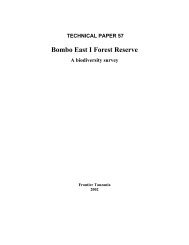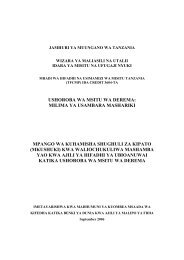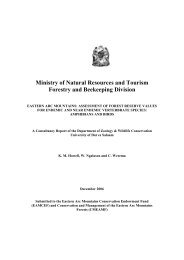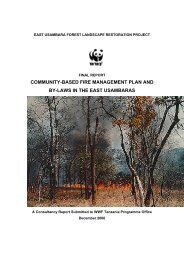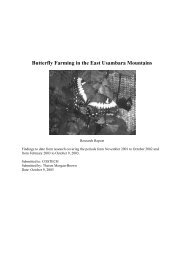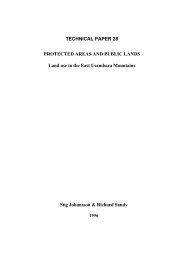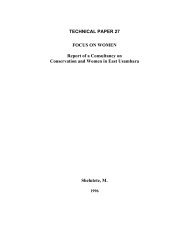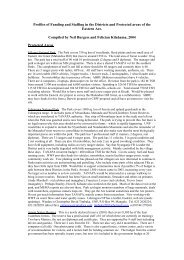Development of Sustainable Forest Use Strategies - Eastern Arc ...
Development of Sustainable Forest Use Strategies - Eastern Arc ...
Development of Sustainable Forest Use Strategies - Eastern Arc ...
You also want an ePaper? Increase the reach of your titles
YUMPU automatically turns print PDFs into web optimized ePapers that Google loves.
Although the Wildlife Conservation Act No. 12 <strong>of</strong> 1974 does not allow hunting without<br />
licences, illegal hunting was observed in the study area, particularly in Udzungwa and<br />
North Pare and East Usambaras. Notwithstanding, hunting is conducted in a very<br />
unsustainable manner. Poor hunting methods such as through the use <strong>of</strong> snares, noose<br />
traps, pit fall traps, log-fall traps, spike trap, spears and dogs are used. Studies on animal<br />
census and hunting intensity have shown that hunting reduces populations <strong>of</strong> wild<br />
animals. For example, bush pig and Abbot’s duiker in New Dabaga/Ulangambi <strong>Forest</strong><br />
Reserve (NDUFR) appear to be severely depleted.<br />
The most hunted animals include bush hyrax (Heterohyrax spp), tree hyrax (Dendrohyrax<br />
validus), rock hyrax (Provavia spp) and Elephant shrews (Macroscelidea). Other hunted<br />
animals include bush pigs, warthogs, antelopes, buffaloes, elephants, primates (such as<br />
Iringa red colobus, Angolan black and white colobus and Sykes monkeys), giant pouched<br />
rat, bushbuck, blue duiker, Livingstone’s suni, red duiker, Abbott’s duiker and other small<br />
animals.<br />
The following strategies are proposed to ensure sustainable hunting: Create awareness<br />
among local communities, improve enforcement <strong>of</strong> laws and by-laws through the<br />
involvement <strong>of</strong> local communities, and introduce incentive systems to enhance<br />
communities’ involvement and commitment. In addition, facilitation <strong>of</strong> improved animal<br />
husbandry through enhancement <strong>of</strong> domestic sources <strong>of</strong> meat and eggs, e.g. by<br />
increasing the number <strong>of</strong> domestic animals to the poorest part <strong>of</strong> the population could<br />
provide a better alternative to wild meat. Projects such as poultry keeping, which has<br />
relatively rapid turnover compared to other livestock, require less capital and running<br />
costs, and can be easily managed by poor households should be introduced. There is<br />
need to strengthen vermin control units to protect crops grown by communities around<br />
forest reserves or national parks. Furthermore, there is need to carry out animal census<br />
and determine sustainable harvesting levels.<br />
On the other hand, regardless <strong>of</strong> the high potential <strong>of</strong> wildlife trade, little is known about<br />
species involved, distribution and harvestable/cropping levels. Not withstanding, there is<br />
evidence <strong>of</strong> people being involved in the business, e.g. the collection <strong>of</strong> animals for pet<br />
trade which was observed in Udzungwa mountain block.<br />
The following strategies are proposed to improve and sustain wildlife trade: encouraging<br />
surrounding villages to form production groups and farming <strong>of</strong> wild animal species<br />
(insects, reptiles, birds, mammals etc.) in an ecologically sustainable way for subsistence<br />
and trade. Cane rats (Thryonomys swinderianus) probably holds high potential; not only<br />
do they breed quickly but are likely to be culturally acceptable. Other species that have<br />
been farmed for their meat in Africa include the Brush-tailed porcupine (Atherurus<br />
africanus), Giant rat (Cricetomis emini), Red river hog (Potamochoerus porcus), Duikers<br />
(Cephalophus spp.), Giant African snail (<strong>Arc</strong>hachatina marginata), Helmeted guinea fowl<br />
(Numida meleagris), Double-spurred francolin (Francolinus bicalcaratus) and Scaly<br />
francolin (Francolinus squamatus). Only some <strong>of</strong> these are found in the <strong>Eastern</strong> <strong>Arc</strong><br />
region. In addition, promotion <strong>of</strong> community-based eco-tourism could serve as another<br />
source <strong>of</strong> income for the communities.<br />
iii



